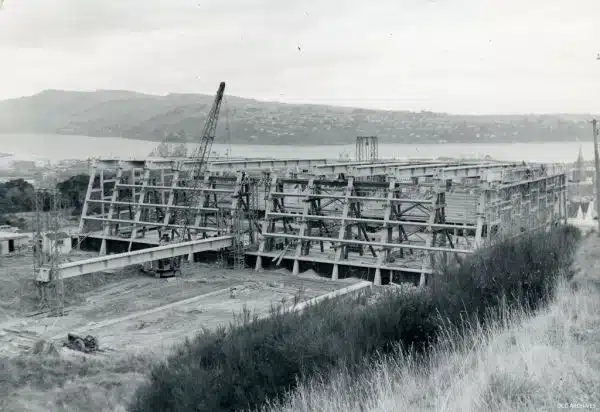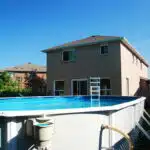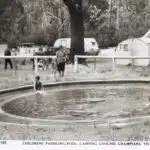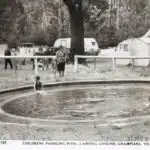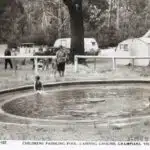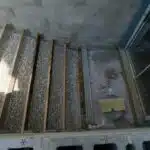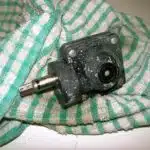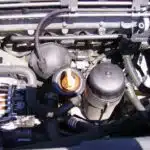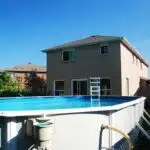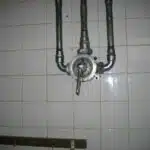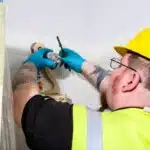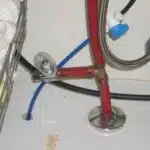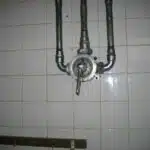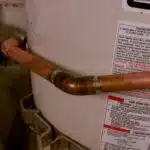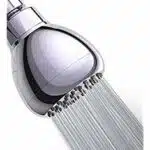Effective pool maintenance requires regular cleaning and proper upkeep. One essential aspect of pool maintenance is backwashing, a process that removes the accumulated debris and contaminants from the filter system. Backwashing is a crucial step in maintaining water quality and ensuring that the pool remains healthy and safe for use.
As a pool maintenance technician, I have seen firsthand how neglecting to backwash can lead to problems such as cloudy water, poor circulation, and even equipment failure. In this article, I will provide you with step-by-step instructions on how to backwash your pool correctly. By following these guidelines, you can keep your pool clean, clear, and functioning optimally while also providing an enjoyable and safe swimming experience for yourself and others.
Understanding The Importance Of Backwashing
Pool maintenance is an essential aspect of owning a pool. It involves several steps, including backwashing, which is crucial to maintaining the quality of pool water. Backwashing entails removing debris and contaminants from the filter by reversing the flow of water through it. The importance of chemicals in pool maintenance cannot be overstated, but even with proper chemical treatments, backwashing is still necessary to keep your pool clean and healthy.
Backwashing should be done frequently to ensure that your pool water remains clean and safe for use. How often you should backwash depends on various factors such as usage frequency, weather conditions, and the level of debris in your pool. A good rule of thumb is to backwash once every week or two, but this could change during periods when the pool sees heavy use or if there are heavy rainfalls.
Failing to backwash your pool regularly can lead to problems such as cloudy water or algae growth. In extreme cases, it can render your swimming pool unusable due to unsafe levels of bacteria and other contaminants. Therefore, it’s vital that you understand the importance of backwashing and make it a part of your regular maintenance routine. In the next section, we will discuss some signs that your pool needs backwashing so that you can take action before any damage occurs.
Signs That Your Pool Needs Backwashing
It is important to recognize the signs that your pool needs backwashing. One of the most common causes is when the pressure gauge on your filter reads 8-10 psi above the normal operating level. This indicates that there is a buildup of debris in your filter and it needs to be backwashed. Another sign is when the water flow into your pool becomes weak or slows down. This can happen when there is a high level of dirt, sand, or other debris in your filter system.
To prevent these issues, regular maintenance of your pool’s filter system should be conducted. Make sure to clean out any baskets or strainers regularly and remove any visible debris from the surface of the water. Additionally, it is recommended to chemically treat your pool at least once a week to keep it balanced and free of contaminants.
By recognizing these common causes and following prevention tips, you can ensure that your pool operates efficiently and effectively throughout its lifespan. In our next section, we’ll discuss what you’ll need for backwashing and how to properly execute this maintenance task.
What You’ll Need For Backwashing
Backwashing a pool requires a backwash hose to be connected to the filter system. The backwash hose should be long enough to reach a suitable area where the water can be drained away. The filter media should be cleaned regularly to ensure the efficiency of the filtration system. To backwash a pool, the filter media must be removed from the filter system and replaced after the backwash process is complete.
Backwash Hose
The backwash hose is an essential tool for maintaining a pool’s cleanliness and clarity. This piece of equipment is designed to carry waste water away from the pool filter system during backwashing. The benefits of using a backwash hose are undeniable – it prevents the dirty water from returning to the pool, which could negatively affect its overall quality.
To ensure that you’re getting the most out of your backwash hose, proper storage is crucial. Best practices for storing a backwash hose include keeping it clean and dry to prevent mold or mildew growth, avoiding exposure to direct sunlight or extreme temperatures, and coiling it neatly after use. By taking care of your backwash hose in this way, you’ll be able to extend its lifespan and maintain its effectiveness.
Overall, incorporating a backwash hose into your pool cleaning routine can save time and effort while improving water quality. Remembering to store it properly when not in use will help ensure that it remains functional for years to come. As a pool maintenance technician, I highly recommend investing in a high-quality backwash hose as part of your essential pool cleaning tools.
Filter Media
When it comes to maintaining a pool’s cleanliness and clarity, backwashing is an essential part of the process. However, this task cannot be completed effectively without the use of appropriate filter media. Filter media refers to the material used in a pool filter to trap and remove dirt, debris, and other unwanted particles from the water.
There are several types of filter media available on the market today. The most common ones include sand, diatomaceous earth (DE), and cartridge filters. Sand filters are excellent for removing large particles such as leaves and twigs from the water. DE filters offer superior cleaning efficiency by trapping even the smallest particles such as bacteria and algae. Cartridge filters are easy to maintain and cost-effective but may require more frequent cleaning than other types.
Choosing the right filter media for your pool depends on various factors such as pool size, usage frequency, and personal preferences. As a pool maintenance technician, I recommend consulting with a professional to determine which type of filter media is best suited for your specific needs. By investing in quality filter media and performing regular maintenance tasks such as backwashing, you can ensure that your pool remains clean and safe for swimming throughout the season.
Shutting Down The Pool System
As pool maintenance technicians, our ultimate goal is to ensure that the pool system is always functioning optimally. We have talked about how to backwash a pool, but now it’s time to prepare for winterization. This involves shutting down the entire system so that it doesn’t get damaged by the harsh winter weather.
Pool system maintenance is essential for ensuring that the system lasts long and operates efficiently. Therefore, before shutting down the pool for winter, there are several things you need to do. Firstly, clean out all debris from the skimmer basket and pump strainer. Secondly, lower the water level below the skimmer opening to prevent any damage from ice expansion during winter.
Preparing for winterization also means removing all accessories such as ladders, diving boards, and slides from the pool area. You should also disconnect any hoses or pumps attached to these accessories and store them safely away from freezing temperatures. Once you have completed all of these steps, you can then proceed with changing the valve position in preparation for reopening your pool in spring.
Changing The Valve Position
Valve maintenance is essential to keep your pool in good condition. A valve is an integral component of the pool’s filtration system, which helps to control the flow of water. If you experience any issues with the valve, it can affect the entire pool system.
Troubleshooting valve issues should be done regularly to ensure that your pool functions smoothly. Some common signs of a faulty valve include leaking water, difficulty turning the handle, and reduced water flow. If you notice any of these symptoms, it is important to address them as soon as possible before they lead to more significant problems.
To change the valve position, start by turning off the pump and closing all valves leading into and out of the filter system. Next, rotate the multiport valve handle until it lines up with “backwash.” It is essential to read your owner’s manual or consult a professional if you are unsure how to change your specific type of valve. Finally, allow for any remaining water in the system to drain before proceeding with starting the backwash process.
Starting The Backwash Process
To start the backwash process, you need to ensure that the pool pump is turned off. This is important because if the pump is left on during backwashing, it can cause damage to the filter system. After turning off the pump, you need to locate the backwash valve on your filter system. This valve is usually located near the filter and has a handle or lever that you need to turn or push.
Once you have located the backwash valve, you need to adjust it so that it directs water flow out of your pool and into a drain or waste area. It’s important to note that you should never direct this wastewater into a storm drain or any other area where it could contaminate local water sources. After adjusting the valve, turn on your pool pump and let it run for approximately 2-3 minutes.
The backwash frequency and duration will depend on various factors such as pool usage, debris accumulation, and water quality. However, in general, it’s recommended that you backwash your pool once every week during peak swimming season and once every two weeks during off-peak season. The duration of the process will depend on how dirty your filters are but generally lasts between 2-5 minutes. By following these guidelines, you can ensure that your pool remains clean and safe for use by all swimmers.
As part of proper pool maintenance, monitoring the waste water from backwashing is essential. You should observe whether there are any abnormalities in color or smell as this could indicate an issue with your pool water chemistry or filtration system. Additionally, make sure to dispose of this wastewater properly by following local regulations and guidelines. By taking these steps towards proper pool maintenance, you can enjoy a clean and healthy swimming environment for years to come.
Monitoring The Waste Water
As a pool maintenance technician, it is crucial to monitor the waste water during the backwashing process. Backwashing helps remove accumulated debris from the filter and returns clean water to the pool. However, this process also generates a large amount of wastewater that can have an environmental impact if not disposed of correctly.
To minimize the environmental impact of backwashing, it is important to monitor the amount of wastewater generated and ensure that it does not overflow into storm drains or nearby bodies of water. One way to conserve water during backwashing is by using a discharge hose that redirects the wastewater to an appropriate drainage area or storage tank. Additionally, monitoring the quality of the wastewater can help identify potential pollutants such as chemicals or algae that may require further treatment before disposal.
As a pool maintenance technician, it is our responsibility to ensure that we minimize any negative environmental impact while conserving water during pool maintenance procedures. Monitoring waste water during backwashing can go a long way in achieving these goals. By redirecting and treating wastewater appropriately and regularly checking for pollutants, we can protect both our customers’ pools and the environment around us. This brings us to the next step in pool maintenance – rinsing the filter.
Rinsing The Filter
After monitoring the waste water, it’s time to move on to the next step in backwashing your pool – rinsing the filter. But before we get into that, let’s discuss some common mistakes and best practices when it comes to backwashing. One of the most common mistakes people make is not backwashing frequently enough. This can lead to dirty water and a clogged filter. It’s recommended that you backwash your pool at least once a week, or more if you have heavy usage.
Another mistake people make is not backwashing for long enough. To ensure that all of the dirt and debris is removed from your filter, you should backwash for at least two minutes or until the water runs clear. If you don’t backwash for long enough, you’ll end up with dirty water again soon after.
Once you’ve finished backwashing, it’s important to check the pressure gauge on your pool equipment. The pressure gauge will tell you if your filter is working properly or if it needs cleaning or replacing. If the pressure gauge shows a reading above 10 PSI higher than when your filter was clean, then it’s time to clean or replace your filter. Checking the pressure gauge regularly will help keep your pool running smoothly and prevent any potential problems down the line.
Checking The Pressure Gauge
The pressure gauge is an essential tool used to monitor the filter’s performance and determine when it is time to backwash the pool. To check the pressure gauge, locate it on the top or side of the filter tank. The gauge measures the pressure inside the filter unit and should be read when the pump is running.
If your pool’s pressure gauge reading is high, it may be time to backwash. However, if it reads low, you may have a problem with low water flow due to dirty skimmer baskets or clogged filters. Troubleshooting low pressure requires checking all components of your pool equipment and cleaning as necessary.
Markdown format bullet points:
- Locate pressure gauge on filter tank
- Read gauge while pump is running
- High reading may indicate a need for backwashing
- Low reading may indicate a problem with water flow
- Troubleshoot by checking all pool equipment components
Now that you know how to check your pool’s pressure gauge and troubleshoot low pressure issues, it’s time to move on to returning the valve to its normal position.
Returning The Valve To Normal Position
After successfully backwashing your pool, the next step is to return the valve to its normal position. This ensures that the filtration system will work properly and prevent any issues from occurring in the future. But how do you go about doing this?
First, turn off the pump motor and move the valve handle to its original position. If you are unsure of what position it should be in, consult your owner’s manual or contact a professional pool maintenance technician for assistance. Once you have returned the valve to its normal position, double-check that it has been secured tightly in place.
Valve maintenance is crucial for ensuring that your pool’s filtration system runs smoothly. Troubleshooting tips include checking for any leaks or cracks in the valve housing, as well as making sure that all bolts and fittings are tightened securely. By taking these measures, you can prevent costly repairs and prolong the life of your pool equipment.
| Valve Position | Function |
|---|---|
| Backwash | Reverses water flow to remove debris from filter |
| Rinse | Flushes out any remaining debris before returning to filter mode |
| Filter | Normal filtration mode |
| Closed | Shuts off water flow completely |
As you finish returning the valve to its normal position, keep in mind that proper maintenance is key to avoiding future problems with your pool system. In order to ensure that everything is working properly, consider setting up a regular maintenance schedule with a professional technician who can inspect and service your equipment as needed. This will give you peace of mind knowing that your pool is always ready for use when you need it most.
Transition: Now that we have returned the valve to its normal position and ensured its proper functioning, let’s move on to restarting the pool system.
Restarting The Pool System
- Drain and refill is an essential part of restarting the pool system and should be done before assembling the equipment.
- Before draining the pool, it is important to disconnect the filter, pump and other equipment to prevent damage.
- Assembling the equipment requires the filter to be connected to the pump and the pump to the return line.
- Once the equipment is assembled and the pool is refilled, the system is ready to be turned on and the water can begin to circulate.
Drain And Refill
As a pool maintenance technician, it is important to understand the process of draining and refilling a pool. While this may seem like the easiest solution to restarting a pool system, it can also lead to potential risks and water conservation issues. It is important to consider alternative solutions before taking this step.
Water conservation should be at the forefront of every pool owner’s mind when considering draining and refilling a pool. This process not only wastes large amounts of water but can also increase your water bill significantly. As a technician, it is important to educate your clients on alternative solutions such as using a natural enzyme treatment or backwashing more frequently.
Before draining and refilling a pool, technicians must take safety measures into consideration. Potential risks include damaging the pool structure, causing leaks or cracks in the foundation, and exposing underground pipes or utilities. It is recommended that a professional inspect the area before proceeding with draining and refilling. Proper safety measures must be taken during the process, including wearing protective gear and ensuring that all electrical equipment is turned off.
In conclusion, while draining and refilling may seem like the easiest solution for restarting a pool system, it is important to consider alternative solutions for water conservation purposes. Technicians must also take proper safety measures to avoid any potential risks associated with this process. By educating clients on alternative solutions and taking these precautions into consideration, we can ensure that pools are maintained efficiently and responsibly.
Assembling Equipment
Assembling equipment is an essential step in restarting a pool system. Before beginning any maintenance work, technicians must ensure that they have all the necessary tools needed to complete the job effectively. This may include specialized equipment such as vacuums, brushes, and chemical test kits. It is important to inspect all equipment before use to ensure that it is in good condition and functioning correctly.
Safety precautions must also be taken when assembling equipment. Technicians should wear protective gear, including gloves and safety glasses, to prevent any potential injuries or accidents. They must also follow manufacturer instructions when using chemicals and equipment to avoid any mishaps. Additionally, it is important to keep all electrical components away from water sources and turn off all power sources before starting work.
Assembling equipment requires attention to detail and careful planning. Technicians must ensure that they have all the necessary tools and safety gear before beginning any maintenance work on a pool system. Following manufacturer instructions and taking proper safety measures can help prevent accidents or damage to the pool structure. As a technician, it is our responsibility to prioritize safety while providing quality service for our clients’ pool systems.
Checking For Leaks And Damage
After completing a backwash, it is important to inspect the equipment for any leaks or damage. Checking for leaks and damage can help identify potential problems before they become major issues. As a pool maintenance technician, your role is to ensure that all equipment is functioning properly to maintain optimal pool health.
When inspecting equipment, start by examining the filter tank for any cracks or signs of wear and tear. Check the pipes and valves for any leaks or cracks as well. It is also important to check the pump basket for debris and clean it if necessary. Taking these steps will help ensure that your pool’s filtration system is working efficiently.
Identifying potential problems early on can save you time and money in the long run. If you notice any leaks or damage during your inspection, address them immediately. Ignoring these issues could lead to more significant problems down the line, resulting in costly repairs. By taking preventative measures and maintaining regular inspections, you can keep your pool running smoothly for years to come.
It is crucial to maintain a regular backwashing schedule in order to keep your pool’s filtration system working efficiently. By following this schedule, you can prevent buildup from accumulating in the filter tank and reduce strain on the pump motor. In addition, regularly backwashing your pool ensures that contaminants are removed from the water, keeping it clean and clear. By staying on top of maintenance tasks like backwashing, you can enjoy a healthy and beautiful pool all season long.
Maintaining Regular Backwashing Schedule
After checking for leaks and damage, it’s important to maintain a regular backwashing schedule for your pool. The frequency of backwashing depends on the size of the pool, the usage, and the filtration system you have in place. Generally, it’s recommended to backwash your pool every 2-4 weeks or when the pressure gauge reads 8-10 psi above normal operating pressure.
The importance of frequency in backwashing cannot be overstated. Regular backwashing helps remove debris and contaminants from your pool water, ensuring that it remains clean and healthy for swimmers. It also helps your filtration system work more efficiently, extending its lifespan and reducing maintenance costs over time. If you’re looking to automate your pool maintenance routine, consider investing in a timer or an automated system that can take care of backwashing for you.
One of the benefits of automation is that it can help prevent common backwashing issues such as clogs and blockages. However, if you do encounter problems with your backwashing process, there are a few troubleshooting steps you can take. For example, if water is not flowing properly during backwash mode, check for any obstructions in the pipes or valves. You may also need to replace worn-out parts such as o-rings or gaskets. By staying vigilant about your pool maintenance routine and addressing any issues promptly, you can keep your pool running smoothly all season long.
Troubleshooting Common Backwashing Issues
Common Backwashing Problems and Troubleshooting Tips
While backwashing is an essential process for pool maintenance, it can also lead to various issues. As a pool maintenance technician, I have encountered common backwashing problems such as clogged filter elements, low water pressure, and dirty water discharge. Fortunately, there are troubleshooting tips that you can follow to resolve these issues.
Firstly, if you notice that the water in your pool is not clean after backwashing, the filter elements may be clogged. This issue often arises when large debris such as leaves and twigs accumulate on the filter screens during the backwash cycle. To fix this problem, try cleaning the filter screens manually by removing any visible debris. You may also need to use a degreaser or filter cleaner solution to remove any stubborn contaminants.
Secondly, low water pressure during backwashing can be frustrating and lead to incomplete filtration of your pool. The primary reason for low water pressure is a dirty pump basket or skimmer basket. These baskets collect debris that can cause blockages in the system leading to low water pressure during backwashing cycles. Ensure that you regularly clean your pump and skimmer baskets to prevent this problem.
Thirdly, another common issue during backwashing is dirty water discharge from your pool’s waste line even after multiple washes. The most likely culprit for this issue is a broken lateral in the sand filter system or torn cartridge filters in cartridge systems. A broken lateral will require replacement by a professional technician while torn cartridge filters will need replacement with new ones.
Now that you are aware of common backwashing problems and their troubleshooting tips let us look at professional backwashing services in more detail in our subsequent section.
Professional Backwashing Services
Pool maintenance is crucial to ensure that the pool remains clean and safe for swimming. One of the most important aspects of pool maintenance is backwashing. It is a process in which water flows backward through the filter, removing any dirt or debris that has accumulated. While it may seem like a simple task, backwashing requires expertise and specialized equipment to be carried out effectively. This is where professional backwashing services come into play.
Professional backwashing services offer several benefits to pool owners. Firstly, they have the expertise and experience required to carry out the task effectively. They are equipped with the latest tools and technology, which ensures that the process is carried out efficiently and accurately. This not only saves time but also reduces water wastage, as professionals know exactly how much water is needed for backwashing.
Additionally, hiring a professional for backwashing also offers cost analysis benefits in the long run. Professional technicians can identify any issues with the filtration system during backwashing and address them before they become major problems that require costly repairs or replacements. Regular backwashing by professionals can extend the life of your filtration system, reducing maintenance costs down the line.
In summary, professional backwashing services are essential for maintaining a clean and safe swimming pool. They offer numerous benefits such as expertise, efficiency, accuracy, reduced water wastage, cost analysis benefits in terms of detecting issues early on and extending the lifespan of your filtration system. As a pool owner looking to provide excellent service to your customers or family members using your pool at home- hiring a professional for regular backwashing should be part of your overall maintenance plan.
Conclusion
Understanding the importance of backwashing is crucial for maintaining a clean and healthy pool. Signs that your pool needs backwashing include decreased water flow, cloudy water, and increased pressure on the filter gauge. To begin the process, shut down the pool system and change the valve position to direct water flow to the waste line. Check for leaks and damage before starting the backwash process.
Maintaining a regular backwashing schedule is essential to keeping your pool in top condition. Troubleshooting common issues such as clogged filters or inadequate water flow can help prevent future problems. If you are unsure about how to properly backwash your pool or experience persistent problems, consider seeking professional services.
As a pool maintenance technician, I highly recommend incorporating routine backwashing into your pool maintenance routine. Neglecting this important step can lead to bacteria buildup and other health hazards. By following proper techniques and utilizing necessary equipment, you can ensure a safe swimming environment for yourself and others. Remember: prevention is key!
Image Credits
- “Moana Pool Construction 1963” by Dunedin City Council Archives (featured)

